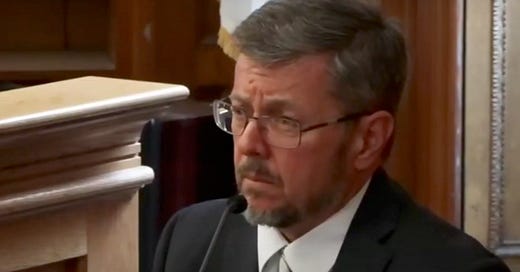DAY 22: Karen Read Retrial
Commonwealth's Biomechanics & Accident Reconstruction Expert takes the stand for second day in a row.
Judge Cannone ruled this morning that the CW’s expert is not allowed to give his opinion that John was hit by Karen Read’s SUV, however he is allowed to give his opinion that the evidence (injuries, vehicle data, etc) is consistent with John being struck by an SUV that is physically identical.
Judson B. Welcher (Accident Reconstructionist and Biomechanics Engineer) was on the stand ALLLL day today again.
DIRECT EXAMINATION (continued):
Dr. Welcher explains the difference between a side swipe impact versus a direct hit with a pedestrian.
Direct hit has a transfer of common energy.
Side swipes don’t have a complete momentum of transfer. (He gives an example of swiping another vehicle and causing the side rearview mirror to break off).
Dr. Welcher confirms his opinion that the injuries on the victim are consistent with a side swipe vehicle incident that impacted the back right taillight.
His conclusion was based on totality of evidence, including:
Physical evidence at the scene.
Photographs of Ms. Read’s vehicle.
Ring video footage (“to a certain extent”).
John O'Keefe's height (including type of shoes he was wearing for measurement).
Locations of the lacerations.
Techstream data.
Welcher says it is very possible that John’s arm impact was what shattered the taillight cover if the vehicle was going over 8 MPH, which the techstream data affirms she reached 24 MPH in reverse.
Prosecution asks if Welcher has come across cases of sideswipe accidents where the pedestrian does not have lower body injuries. Welcher says yes. He presents an example of a similar type case:
The male pedestrian was hit between a 25 to 35 mile an hour impact.
No broken bones.
No lower body injuries.
Vehicle had DNA tissue and victim’s hair on it.
Massive laceration on right arm. Some red marks on body.
Severe brain injury that led to his death.
Welcher measured the height of the SUV’s back spoiler. It is the same height of where John’s right eye had a laceration, and could be the cause of that exact injury.
CROSS-EXAMINATION:
(You might want to stretch and grab a drink before you continue. Cross-exam by Defense Attorney Alessi was a long-winded line of scattered questioning that didn’t seem to go anywhere useful. I tried my best to collect the main points from it.)
Defense Attorney Alessi questions Welcher on the meaning of ‘scientific method’. Welcher agrees the scientific method is to get the the most logical and correct answer without bias.
Welcher says when working with forensics the scientific method also includes testimonial evidence as well if available.
EDR data does not show the location or clock timestamp associated with a techstream event with this vehicle, however it does record the amount of time things occur. Welcher says he used other data points like cellular geolocation data, mileage, etc. to match the events with the clock time and location.
Every techstream event is associated with a particular key cycle on the vehicle.
Welcher’s company, Aperture, was retained by the CW in September 2024.
Aperture’s contract recently had an amendment for $325,000. Welcher does not know if that amount is correct off the top of his head, but says he has no reason to doubt it. He is not in charge of the billing.
Defense questions Welcher if he was already aware that Aperture was paid $44,500 by the Norfolk County District Attorney's Office? Welcher is unsure of what is billed and what isn’t. There are several offices, and he is not the department that receives statements.
Aperture purchased the identical LEXUS to run testing on, and the SUV will be sold after this trial is over. Aperture will then charge the Commonwealth the difference in the price, and if it’s sold for more money, the bill for the CW goes down.
When analyzing an accident, there are more hypotheses in the beginning because you have more questions. You continue to form hypotheses as the data presents itself, so you don't stop the formation of hypotheses. As you get more evidence, the number of questions wind down.
Defense attorney notes that Welcher has made changes over time to the presentation powerpoint slides. Welcher agrees, and says he has continuously changed parts along the way, but hasn’t changed the analysis. (Ex. He had to remove a slide due to something not being allowed by the judge in trial. He was privy to a media interview where Karen describes her route, so he was able to narrow that down, etc.) Welcher says this not uncommon in the trials he has testified for.
Defense questions Welcher about how much force it would take to break the right arm of a human in this situation. Welcher says it would take around 7,000 lbs.
Defense asks if it’s possible to break a bone from a different location on the back a moving SUV. Welchar says possibly near the license plate area if there was force of 300 lbs or more.
Welcher explains the definition of “distributed load”. Example of sitting versus laying on a bed. Sitting will cause mattress to sink deeper because all the weight is in one direct spot, but laying sprawled out will distribute the weight causing less force down on mattress.
Welcher says that the autopsy report does not mention any broken bones below the skull, however there is also no information showing that any X-rays were actually taken of John’s full body.
Defense asks Welcher why he didn’t test the reverse impact at the speed of 20 mph, and Welcher says he’s not gonna let a Lexus reverse at him that fast. They did it slowly to see how the impact and body mechanics of the victim interacted. A crash dummy limits the amount of tests you can do before the car is damaged, so using one wasn’t the best method.
Heavy acceleration on the gas pedal can cause wheels to spin before gaining traction. Welcher believes this occurred briefly.
Defense asks if it’s Welcher’s opinion that John’s arm broke the taillight cover and then maintained some contact still as the car continued to move. Welcher says yes. “This is what happens in pedestrian contacts.” The arm is definitely in contact with the rear of the car for certain amount of time. Welcher asserts that there is not enough info to know how much time was needed to cause John’s abrasions.
Defense asks Dr. Welcher if he used the law of physics when analyzing John’s arm injuries. Welcher says yes, and guides Alessi to certain parts of his report.
Cross-examination continues tomorrow.
(If you got to the end of this recap, you deserve a medallion. And a chocolate bar.)






